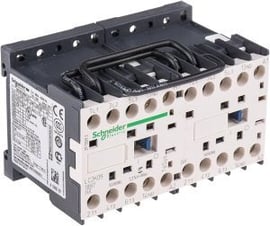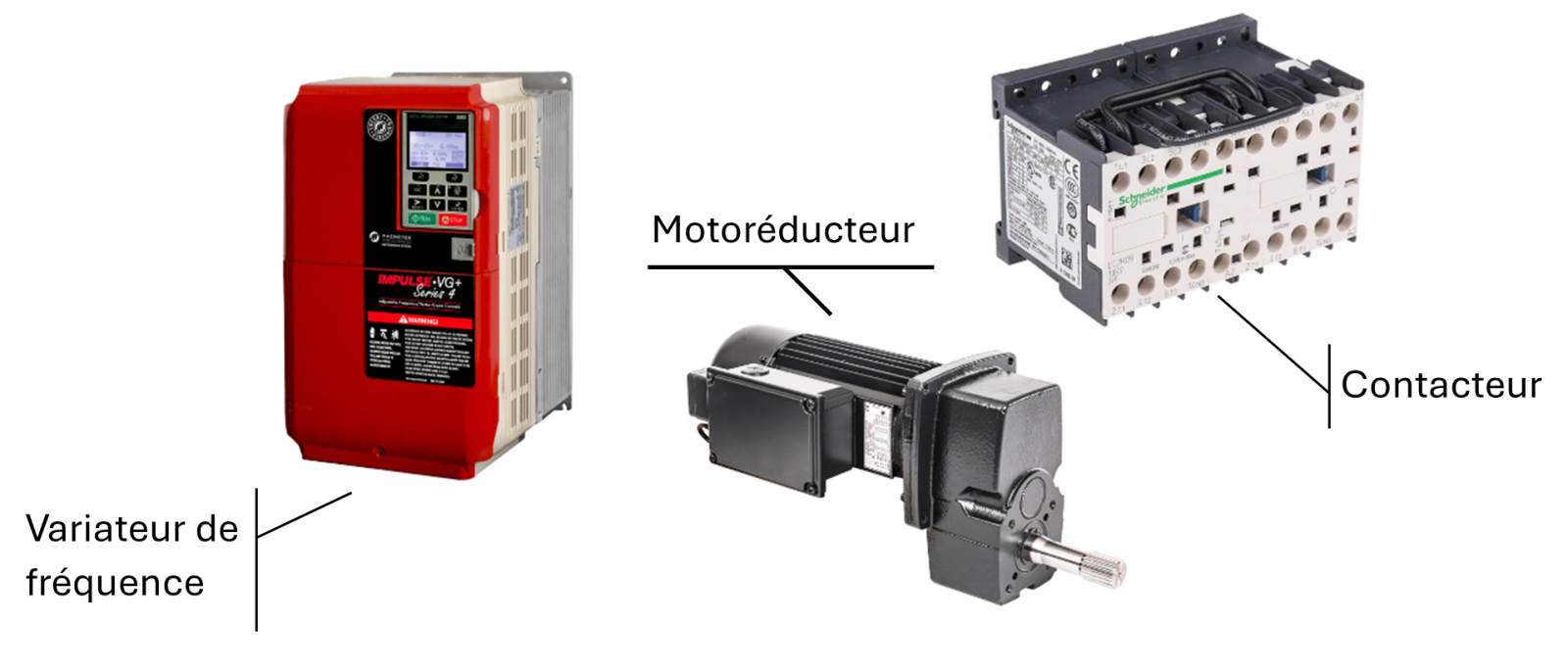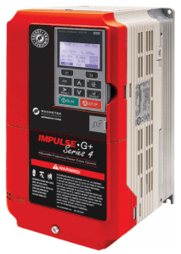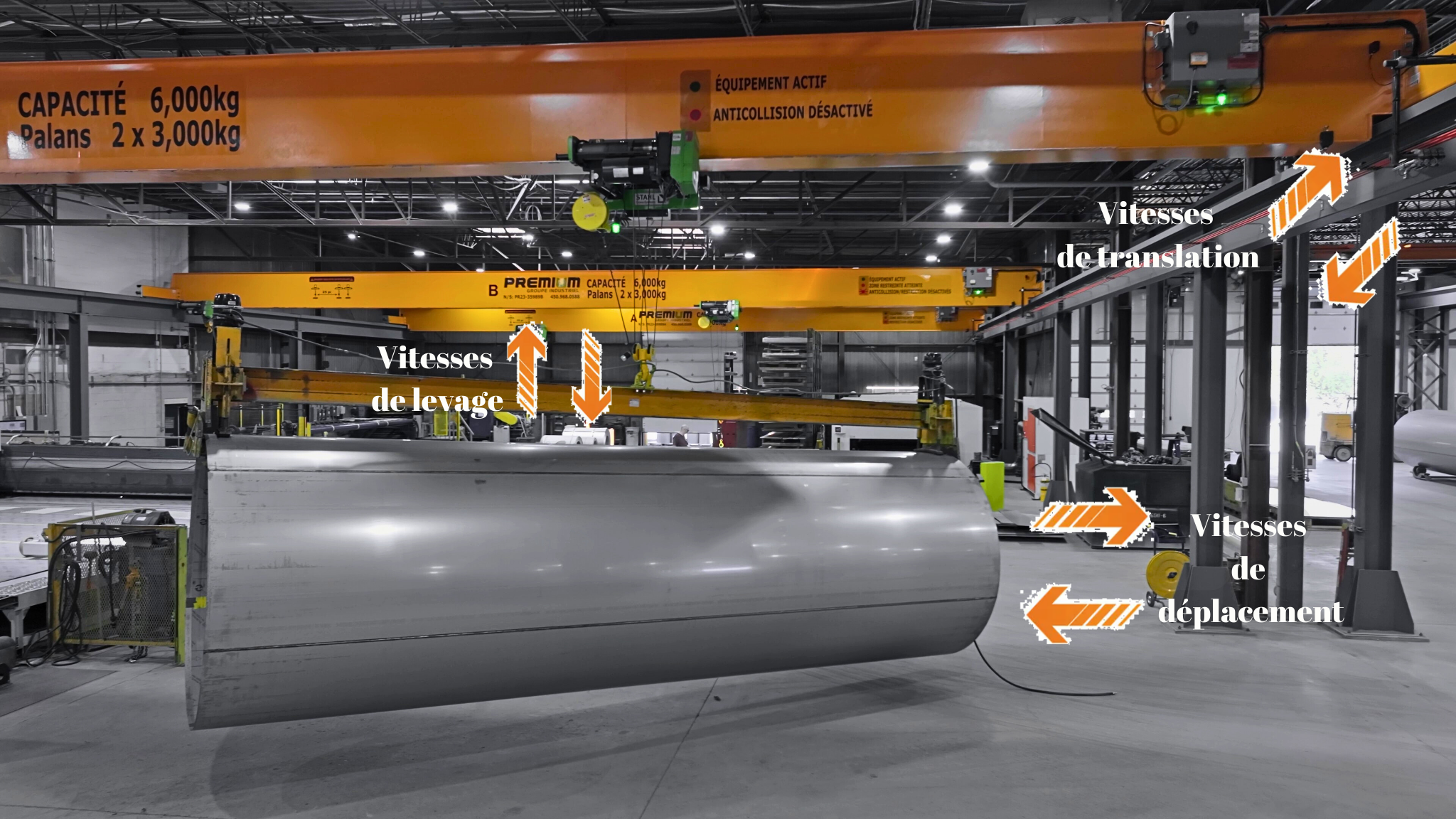-
PRODUCTSreturn
-
SERVICES AND PARTS
-
ABOUT US
Can you change the speeds of an overhead crane after purchase?
8:35
In short…
Theoretically, yes. But in practice, not so much. Using variable frequency drives, speeds can be modified within their available range or reach a slight overspeed. But these changes can only be made under certain conditions. In the case of 2-speed motors, the only way to modify them is to replace major components of the equipment.
Productivity. It’s a word that won’t lose its popularity in the industrial world anytime soon! The faster operations are carried out, the higher the production, which in turn increases profitability. Well, speed isn’t the ultimate value, but if you can do things well… and fast at the same time, you come out winning.
When you buy an overhead crane, you’re told about the different speeds available, and you may think, “At this speed, it’ll do!” But then you get your lifting equipment installed… and disappointment sets in. It’s not fast enough at all (or it goes too fast, who knows!). But there you have it, everything is installed!
What a disappointment to learn, during a discussion with your supplier, that you can’t change the speeds on your equipment! A purchasing error that will cost you greatly: your production has slowed down, whereas you had counted on increased productivity thanks to your new project, causing you income losses compared with estimates.
You’ve just bought an overhead crane, and you realize that its speed doesn’t meet your expectations at all? Are you wondering whether it’s possible to modify this speed – either lifting or travelling – once the equipment is in place?
In this article, I’ll answer this question, which many of my customers at Premium Industrial Group ask me, by explaining when it’s possible to increase or decrease the speed of an overhead crane… and when it’s simply not an option.
You’ll also see what modifications are technically feasible, what compromises you may have to make, and above all, how to avoid such situations by choosing from the outset an equipment suitable to your operations.
First, let’s answer the basic question: can you change the travel and lifting speeds of an overhead crane after purchase?
It is possible to change to the speeds of an overhead crane after purchase?
The answer to this question is yes and no.
As mentioned in the article Do you need a variable speed drive on your overhead crane? The different types of motor and control, there are two main types of motor control: two-speed motors (contactor control) and motors with variable frequency drives (known as “vfd”).
Can the speeds of two-speed equipment be changed?

Contactor
In the case of two-speed motors, it is not possible to change speeds at source, unless major modifications are made to the equipment, which will inevitably involve high costs. Why not? Because contactors can only be used to switch from one speed to the other. The gearmotor is what determines these speeds. It is electrically and mechanically designed for these speeds, and is fitted with wheels (for moving), as well as pulleys and a drum (for lifting) to match these speeds.
As you’d expect, it’s not just a question of replacing one part – the contactors, for example – but of replacing a series of parts, the major costs of which would be akin to replacing the entire component (hoist, gearmotor, etc.).

That said, an option may still be available when it comes to lifting, depending on the equipment’s reeving. For example, if the hoist is reeved in 4/1 to obtain a certain capacity, it remains possible to switch to a 2/1 reeving, which will double the lifting speed. However, this will also halve the hoist’s rated capacity. A very important compromise that you’ll have to be ready to make to obtain this new speed.
Is it possible to modify the speeds of equipment with a variable speed drive?

Variable speed drive
Now let’s talk about equipment fitted with a variable frequency drive. Here again, the electromechanical design of the equipment is based on the speeds decided at the outset. The only difference is that a variable speed drive offers a speed range within which it is possible to vary. If the new desired speeds are within this range, it’s a simple matter of reprogramming. But often, when we talk about changing speeds, it’s often to significantly increase (or decrease) speeds, not to stay within this range.
Let’s take an example: imagine you’re buying an overhead crane equipped with a VFD for lateral travel. The speeds are, for example, from 2.5 to 25m/min. You can ask for the speed range to be changed to a minimum speed of 4m/min and a maximum speed of 20m/min. However, if you want your slow speed to be slower, 1m/min for example, or your fast speed to change to 35m/min, it won’t be possible. Here too, you will need to make the major changes we mentioned earlier.
Another possibility is available with a variable speed drive: you can also increase speed to perform an overspeed maneuver. But this will again involve compromises. For example, you will have to reduce the load by 25% or move without a load to achieve a speed that’s perhaps 20% higher. The equipment manufacturer will be able to indicate the possibilities available. But don’t expect to go from single to double speed for the same reasons: the other components of the equipment are not designed for such speeds.
Knowing this, how can you ensure to have the right speeds for your overhead cranes?
Why is changing the speeds of a crane easier than with an overhead crane ?
Rental cranes on the market are often high-capacity and come with a variety of reeving and counterweight options, offering a wide range of speeds.
Overhead cranes, on the other hand, are custom-built according to the specific needs of the customer's applications and operations. You can't make all these changes at will.
How to choose the right overhead crane speed right from the start
The key to avoiding disappointment when it comes to the speed of your future lifting equipment is to analyse your needs carefully. The application and type of operation will determine the speeds you need. The clearer and more complete this initial information is, the more obvious the choice of speeds will be. But to do this, you need to know what information to gather.
For more information, see the article Need an overhead crane: Where to start? Reading it will help you determine what information is necessary to make the right selection. But don’t forget that there are specialists who can guide you through your project.

Here’s some useful information before contacting your specialist.
- Note the speed of existing equipment : analyzing the speeds of your current equipment will give a good indication.
- Simulate the operation : a simple (almost too simple) method you can employ is to walk from point A to point B at the desired speed, and time the journey. Yes, quite simply. This information will be invaluable during your analysis with your lifting expert.
- Determine your restrictions : are there any restrictions that will dictate the speed you choose? For example, does a part leave a machine every 5 minutes? Do you need to unload three trucks in an hour? Where are the parts located in relation to their destination? At the other end of the factory?
All these elements put together will ensure that you are well-equipped for your discussion with your advisor. It may take some time and a few tests, perhaps without parts, or with a forklift to get as close as possible to reality. But you’ll come out ahead. In other words,… don’t go too fast… in your choice of speeds!
|
|
|
|
|---|---|---|
 |
Only by changing the reeving (reduced capacity) | Yes:
|
  |
No | Yes:
|
Your lifting specialist : an advisor to guide you towards the right speeds
So, is it possible to change the speeds of an overhead crane after purchase? Theoretically yes.. but only in very limited cases, and often at the cost of compromises or major modifications that aren’t worth the trouble. This is therefore not the right way to approach the question.
As we’ve seen, the wrong speed can harm your productivity, slow down your day-to-day operations and turn a promising investment into a source of frustration. That’s why it’s essential to accurately assess your needs right from the selection phase.
At Premium Industrial Group, we help our customers make informed decisions right from the start. Don’t hesitate to contact us – our specialists will be happy to help you configure an overhead crane that meets your requirements, at the right speed.
Technical representative at Premium Industrial Group inc.
Learning Center
Whether you're an expert or know nothing about cranes, you'll find everything you need to know HERE.






